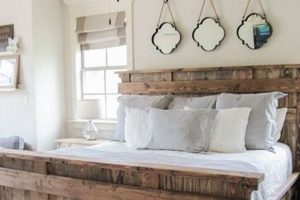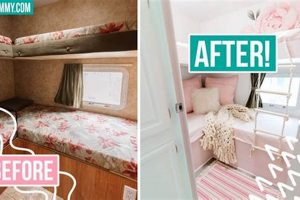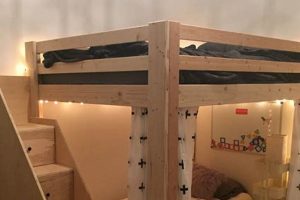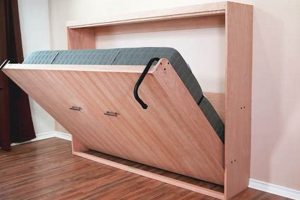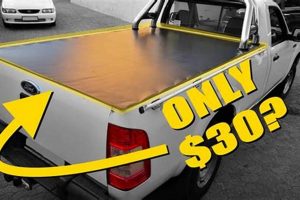A do-it-yourself pull-out bed, often constructed from wood or repurposed materials, presents a space-saving sleeping solution. Commonly stored beneath a standard bed frame, it can be readily deployed to accommodate guests or additional occupants of a room. For instance, a twin-sized unit can be built to slide under a queen-sized bed, effectively maximizing floor area in smaller living spaces.
The construction of a hidden auxiliary bed offers several advantages, including cost savings, customization options, and efficient use of available space. Historical context reveals a longstanding need for adaptable furniture in dwellings with limited square footage, leading to the evolution of designs aimed at maximizing utility. Building it yourself provides a means to tailor dimensions and aesthetics to complement existing decor and specific spatial constraints.
Subsequent sections will address various aspects of constructing these under-bed units, including design considerations, materials selection, step-by-step building instructions, and safety precautions. Further discussion will cover adapting existing furniture, adding storage capacity, and integrating aesthetic features.
Construction Tips for a DIY Trundle Bed
The following guidelines are intended to assist in the successful construction of a space-saving under-bed unit. Adherence to these points will improve the durability and functionality of the finished product.
Tip 1: Accurate Measurement is Crucial: Precisely measure the available space under the existing bed frame to ensure the unit fits properly. Account for the height of the mattress and any necessary clearance for smooth operation.
Tip 2: Prioritize Structural Integrity: Select high-quality lumber or durable materials that can withstand repeated use. Reinforce joints with screws and wood glue for added stability.
Tip 3: Choose Appropriate Hardware: Utilize heavy-duty casters or rollers that can support the weight of the frame and mattress. Select smooth-gliding drawer slides for easy extension and retraction.
Tip 4: Implement a Secure Locking Mechanism: Incorporate a locking system to prevent unintended rolling of the under-bed unit when in use. A simple latch or brake mechanism can enhance safety.
Tip 5: Sand and Finish Surfaces Thoroughly: Sand all surfaces to remove splinters and sharp edges. Apply a durable finish, such as paint or varnish, to protect the wood and improve aesthetics.
Tip 6: Test Functionality Before Final Assembly: Before completing the project, test the sliding mechanism to ensure smooth operation and proper alignment. Make any necessary adjustments to prevent binding or friction.
Tip 7: Consider Ventilation: If the constructed pull-out bed will be used frequently, ensure adequate ventilation to prevent moisture build-up. Drill ventilation holes or use breathable mattress materials.
By following these tips, the resulting piece of furniture will provide a practical and long-lasting sleeping solution.
The subsequent section will explore design considerations and stylistic adaptations applicable to this type of project.
1. Space Optimization
Space optimization is a fundamental consideration in modern living, particularly in urban environments and smaller dwellings. A do-it-yourself under-bed unit offers a tangible solution to spatial constraints by providing a secondary sleeping surface that remains concealed when not in use. Its design inherently addresses the need for efficient utilization of available area.
- Multifunctional Furniture Design
The essence of space optimization lies in the creation of furniture pieces that serve multiple purposes. This project exemplifies this principle by integrating a sleeping surface into an otherwise unused volume beneath an existing bed. This contrasts with dedicating additional floor space to a permanent, standalone bed.
- Vertical Space Utilization
While often overlooked, the vertical dimension represents a significant opportunity for space savings. This furniture arrangement effectively utilizes the vertical space under a bed, transforming it from wasted space into a functional component of the living area. This design principle is also applicable to other forms of storage and organization within a room.
- Adaptable Living Arrangements
These sleeping units enhance the adaptability of living arrangements by accommodating guests or unexpected overnight stays without requiring a dedicated guest room. This adaptability is particularly valuable in apartments or smaller homes where space is limited and flexibility is paramount.
- Clutter Reduction
By providing a readily available and easily accessible sleeping solution, the proliferation of temporary bedding arrangements on sofas or floors can be mitigated. The streamlined storage provided by an under-bed unit contributes to a cleaner and more organized living environment.
In summary, the integration of a DIY pull-out bed reflects a proactive approach to space optimization, addressing the constraints of smaller living spaces while enhancing functionality and adaptability. The principles demonstrated in its design can be applied to a broader range of home improvement projects aimed at maximizing available space and minimizing clutter.
2. Material Selection
Material selection is a critical determinant in the structural integrity, longevity, and aesthetic appeal of a constructed under-bed unit. The choice of materials directly impacts the unit’s weight-bearing capacity, ease of construction, and overall cost-effectiveness.
- Wood Type and Grade
The selection of wood, encompassing species and grade, profoundly affects the pull-out bed’s structural performance. Hardwoods such as oak or maple offer superior strength and resistance to wear, suitable for supporting heavier loads. Softwoods like pine, while more affordable and easier to work with, may necessitate reinforcement to ensure adequate support. The grade of the wood influences its appearance and the presence of knots or imperfections, which can impact structural integrity.
- Plywood and Engineered Wood Products
Plywood and other engineered wood products provide alternative options, offering dimensional stability and resistance to warping. These materials can be cost-effective alternatives to solid wood, particularly for large surface areas such as the bed frame base. The thickness and quality of the plywood are crucial factors in determining its load-bearing capacity and resistance to deflection under weight.
- Fasteners and Adhesives
The selection of appropriate fasteners and adhesives is paramount for secure assembly. Screws offer greater holding power than nails, and wood glue provides a strong bond between wood surfaces. The type of screw or adhesive should be compatible with the selected wood species to prevent corrosion or degradation over time. Proper joint construction, coupled with appropriate fasteners and adhesives, ensures the structural integrity of the entire unit.
- Finishing Materials
Finishing materials, including paints, stains, and sealants, protect the wood from moisture damage and enhance its aesthetic appeal. The choice of finish should be based on the desired appearance and the level of protection required. Durable finishes, such as polyurethane, offer resistance to scratches and abrasion, while stains allow the natural wood grain to show through. Proper surface preparation, including sanding and priming, is essential for achieving a professional-looking finish.
The careful evaluation of these material considerations is essential for constructing a durable, functional, and aesthetically pleasing space-saving bed. A well-informed selection process contributes directly to the overall success and longevity of the project.
3. Rolling Mechanism
The rolling mechanism is an integral component of any space-saving under-bed unit, directly impacting its ease of use and overall functionality. A properly designed and implemented rolling mechanism allows for smooth and effortless extension and retraction of the bed, essential for its practical application. Failure to adequately address this aspect can result in a cumbersome and difficult-to-operate sleeping surface. For instance, insufficient caster size or poor-quality bearings will lead to increased friction, making the unit difficult to pull out or push back into place. Inadequate weight distribution across the casters can cause uneven rolling and potential damage to flooring.
Selecting the appropriate type and size of casters or rollers is paramount. Considerations include the weight-bearing capacity of each caster, the type of flooring the unit will be rolling on, and the desired height clearance. Hardwood floors require soft rubber or polyurethane casters to prevent scratching, while carpeted surfaces may benefit from larger diameter casters that can roll over the fibers more easily. Furthermore, the placement of casters should be strategically considered to distribute weight evenly and minimize stress on the frame. Incorporating locking casters is a practical safety measure, preventing unintentional rolling when the bed is in use. This ensures stability and reduces the risk of injury.
In summary, the rolling mechanism is not merely an accessory but a critical determinant of the success of a space-saving bed project. Careful selection, placement, and maintenance of the rolling components are necessary to ensure smooth operation, durability, and safety. Neglecting this aspect can lead to a functionally compromised unit, negating the benefits of space optimization. The functionality of the rolling mechanism directly influences user experience, solidifying its significance within the broader context of do-it-yourself under-bed unit construction.
4. Structural Support
Structural support constitutes a foundational element in the design and construction of a do-it-yourself under-bed unit. The integrity of the structure directly correlates with its ability to safely and effectively bear weight, resist stress, and maintain its form over prolonged use. A lack of adequate structural support can manifest in various detrimental effects, including frame deformation, joint failure, and ultimately, potential collapse, rendering the unit unusable and unsafe. For instance, utilizing insufficiently sized lumber for the frame or neglecting to reinforce corners can lead to sagging under the weight of a mattress and occupant.
The implementation of appropriate structural elements is essential for mitigating these risks. This includes selecting wood species with adequate load-bearing capacity, employing robust joinery techniques such as mortise and tenon or reinforced screw connections, and incorporating strategically placed support beams or stringers to distribute weight evenly across the frame. Consider a practical example: constructing a twin-sized unit with 2×4 lumber for the frame and adding a central support beam running lengthwise beneath the mattress. This design enhancement distributes the load, preventing bowing or warping over time. Furthermore, the selection of high-quality fasteners, such as screws designed for structural applications, contributes to the long-term stability of the frame.
In summary, structural support is not merely a design consideration but an imperative for the safe and reliable operation of a space-saving bed. A thorough understanding of load-bearing principles, coupled with the careful selection of materials and construction techniques, is essential for creating a durable and functional unit. Addressing this aspect proactively ensures the long-term utility and safety of the sleeping arrangement. Any compromise in structural integrity can have cascading effects, undermining the entire purpose of the project.
5. Safety Features
The incorporation of safety features is paramount in the construction of a do-it-yourself space-saving bed, ensuring the well-being of users and mitigating potential hazards associated with its operation. These features address inherent risks related to moving parts, weight distribution, and stability, directly influencing the overall safety profile of the finished product.
- Locking Mechanisms
Locking mechanisms are critical for preventing unintended movement of the under-bed unit when in use. Casters equipped with locking levers or brakes restrict wheel rotation, maintaining the bed’s position and preventing it from rolling during occupancy. The absence of such mechanisms can lead to instability, particularly on uneven surfaces, posing a risk of injury to the user.
- Smooth Edges and Rounded Corners
Mitigating sharp edges and corners is essential for minimizing the risk of cuts and abrasions. Sanding all surfaces and rounding off corners reduces the likelihood of accidental injury during use or interaction with the bed. This is especially pertinent in environments where children are present, as they are more prone to accidental contact with furniture.
- Adequate Ventilation
Ensuring adequate ventilation beneath the mattress prevents the build-up of moisture and the potential growth of mold or mildew. Ventilation holes or breathable mattress materials promote air circulation, reducing the risk of respiratory issues and maintaining a hygienic sleeping environment. This consideration is particularly relevant in humid climates or in situations where the bed is frequently used.
- Secure Fasteners and Joinery
Employing secure fasteners and robust joinery techniques is fundamental for maintaining the structural integrity of the unit. Screws, bolts, and wood glue, when used appropriately, create strong and durable connections that can withstand repeated use and weight-bearing stresses. Weak or poorly constructed joints can compromise the stability of the bed, increasing the risk of collapse or structural failure.
These safety features, when integrated thoughtfully into the design and construction process, significantly enhance the safety and usability of a constructed auxiliary bed. Their implementation reflects a commitment to user well-being and mitigates potential hazards associated with this type of space-saving furniture. Prioritizing safety considerations ensures that the finished product is not only functional but also poses minimal risk to its occupants.
Frequently Asked Questions
The following section addresses common inquiries and concerns regarding the construction and implementation of space-saving under-bed units.
Question 1: What is the expected lifespan of a properly constructed pull-out bed?
The lifespan of such a bed is contingent upon material quality, construction techniques, and usage frequency. A unit built with high-grade lumber and employing robust joinery can reasonably be expected to last for several years, potentially exceeding a decade with proper maintenance.
Question 2: What are the primary safety concerns associated with such a bed?
Key safety considerations include the stability of the rolling mechanism, the absence of sharp edges or corners, and adequate ventilation beneath the mattress. Implementation of locking casters and smooth surface finishing are essential preventative measures.
Question 3: What is the optimal mattress thickness for a pull-out bed?
The optimal mattress thickness depends on the available vertical space beneath the primary bed frame. Generally, a mattress thickness ranging from 6 to 8 inches provides adequate comfort while allowing for smooth retraction of the unit.
Question 4: What are the material cost considerations for a pull-out bed project?
Material costs vary depending on the selected wood species, the complexity of the design, and the quality of hardware components. Detailed cost estimations should be conducted prior to commencement of the project to ensure budgetary adherence.
Question 5: What tools are required for the construction of a pull-out bed?
Essential tools include a measuring tape, saw (circular or hand saw), drill, screwdriver, sander, and various hand tools for joinery and finishing. Access to a table saw can significantly enhance the efficiency of the project.
Question 6: What are the space requirements for operating such a bed?
The required space for operation is determined by the dimensions of the unit when fully extended. Adequate clearance should be maintained around the bed to allow for comfortable access and movement.
The information presented in this FAQ section provides a foundational understanding of the key considerations associated with constructing a space-saving under-bed unit.
The subsequent section will delve into design variations and customization options for this type of furniture project.
Conclusion
The preceding exploration of the DIY trundle bed has elucidated critical aspects pertaining to design, construction, safety, and material considerations. Adherence to the principles outlined ensures the creation of a functional and durable space-saving sleeping solution. Attention to structural integrity and meticulous implementation of safety features are paramount.
The construction of a DIY trundle bed represents a practical approach to optimizing limited living spaces. The successful completion of such a project requires diligent planning, careful execution, and a commitment to upholding safety standards. Future developments may incorporate innovative storage solutions and enhanced rolling mechanisms, further increasing the utility of this adaptable furniture form.


